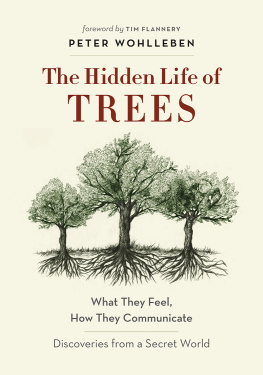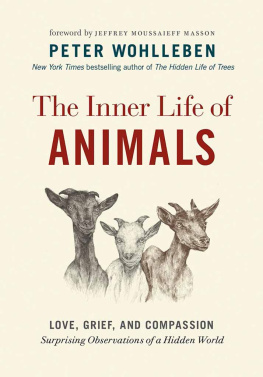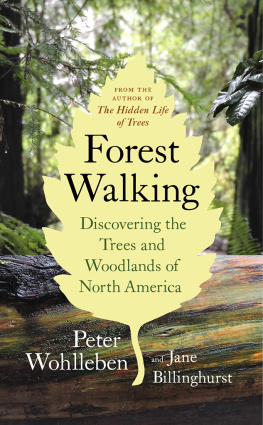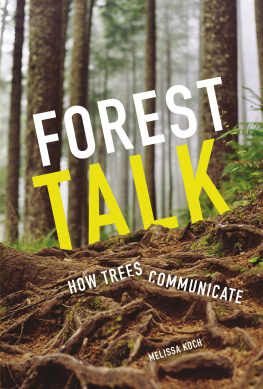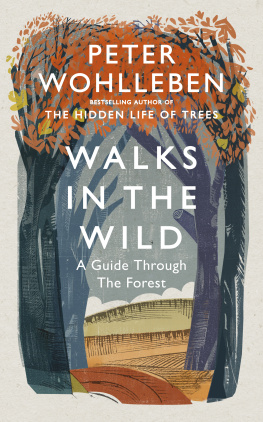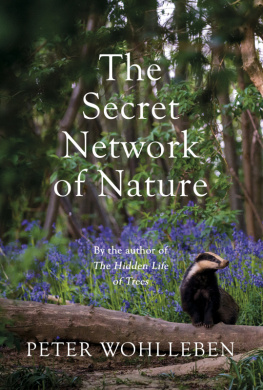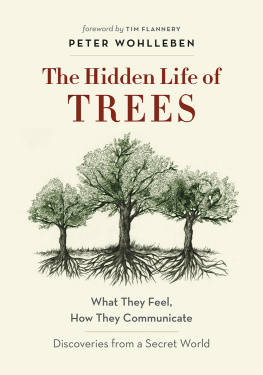THE DAVID SUZUKI INSTITUTE is a non-profit organization founded in 2010 to stimulate debate and action on environmental issues. The Institute and the David Suzuki Foundation both work to advance awareness of environmental issues important to all Canadians.
We invite you to support the activities of the Institute. For more information please contact us at:
David Suzuki Institute
2192211 West 4th Avenue
Vancouver, BC , Canada V6K 4S2
info@davidsuzukiinstitute.org
604-742-2899
www.davidsuzukiinstitute.org
Cheques can be made payable to The David Suzuki Institute.
foreword by TIM FLANNERY
PETER WOHLLEBEN
TRANSLATION BY JANE BILLINGHURST
THE HIDDEN LIFE OF
TREES
What They Feel,
How They Communicate
Discoveries from a Secret World
Copyright 2015 by Ludwig Verlag, Munich, part of the Random House GmbH publishing group
Originally published in Germany in 2015 as Das geheime Leben der Bume
English translation copyright 2016 by Jane Billinghurst
Foreword copyright 2016 by Tim Flannery
Note from a Forest Scientist copyright 2016 by Dr. Suzanne Simard
All rights reserved. No part of this book may be reproduced, stored in a retrieval system, or transmitted, in any form or by any means, without the prior written consent of the publisher or a license from The Canadian Copyright Licensing Agency (Access Copyright). For a copyright license, visit www.accesscopyright.ca or call toll free to 1-800-893-5777.
Greystone Books Ltd.
www.greystonebooks.com
David Suzuki Institute
2192211 West 4th Avenue
Vancouver, BC , Canada V6K 4S2
Cataloguing data available from Library and Archives Canada
ISBN 978-1-77164-248-4 (cloth)
ISBN 978-1-77164-249-1 (epub)
Copyediting by Shirarose Wilensky
Jacket design by Nayeli Jimenez
Jacket and interior illustrations by Briana Garelli
We gratefully acknowledge the financial support of the Canada Council for the Arts, the British Columbia Arts Council, the Province of British Columbia through the Book Publishing Tax Credit, and the Government of Canada through the Canada Book Fund for our publishing activities.
FOREWORD
WE READ IN fairy tales of trees with human faces, trees that can talk, and sometimes walk. This enchanted forest is the kind of place, I feel sure, that Peter Wohlleben inhabits. His deep understanding of the lives of trees, reached through decades of careful observation and study, reveals a world so astonishing that if you read his book, I believe that forests will become magical places for you, too.
One reason that many of us fail to understand trees is that they live on a different time scale than us. One of the oldest trees on Earth, a spruce in Sweden, is more than 9,500 years old. Thats 115 times longer than the average human lifetime. Creatures with such a luxury of time on their hands can afford to take things at a leisurely pace. The electrical impulses that pass through the roots of trees, for example, move at the slow rate of one third of an inch per second. But why, you might ask, do trees pass electrical impulses through their tissues at all?
The answer is that trees need to communicate, and electrical impulses are just one of their many means of communication. Trees also use the senses of smell and taste for communication. If a giraffe starts eating an African acacia, the tree releases a chemical into the air that signals that a threat is at hand. As the chemical drifts through the air and reaches other trees, they smell it and are warned of the danger. Even before the giraffe reaches them, they begin producing toxic chemicals. Insect pests are dealt with slightly differently. The saliva of leaf-eating insects can be tasted by the leaf being eaten. In response, the tree sends out a chemical signal that attracts predators that feed on that particular leaf-eating insect. Life in the slow lane is clearly not always dull.
But the most astonishing thing about trees is how social they are. The trees in a forest care for each other, sometimes even going so far as to nourish the stump of a felled tree for centuries after it was cut down by feeding it sugars and other nutrients, and so keeping it alive. Only some stumps are thus nourished. Perhaps they are the parents of the trees that make up the forest of today. A trees most important means of staying connected to other trees is a wood wide web of soil fungi that connects vegetation in an intimate network that allows the sharing of an enormous amount of information and goods. Scientific research aimed at understanding the astonishing abilities of this partnership between fungi and plant has only just begun.
The reason trees share food and communicate is that they need each other. It takes a forest to create a microclimate suitable for tree growth and sustenance. So its not surprising that isolated trees have far shorter lives than those living connected together in forests. Perhaps the saddest plants of all are those we have enslaved in our agricultural systems. They seem to have lost the ability to communicate, and, as Wohlleben says, are thus rendered deaf and dumb. Perhaps farmers can learn from the forests and breed a little more wildness back into their grain and potatoes, he advocates, so that theyll be more talkative in the future.
Opening this book, you are about to enter a wonderland. Enjoy it.
TIM FLANNERY
INTRODUCTION TO
THE ENGLISH EDITION
WHEN I WROTE this book, I wanted to describe my experiences in the forest I manage in the Eifel mountains in Germany and record what the trees had taught me. As soon as the German edition of the book was published, it was clear that the story I had to tell struck a chord with many, many people. My message, though grounded in a forest I interact with almost every day, is a message that applies to forests and woodlands around the world.
I am most familiar with the struggles and strategies of beeches and oaks, and with the contrast between deciduous forests that plan their own futures and coniferous forests planted for commercial gain. However, the struggles and strategies in forests left to their own devices, and the tension created when forests are planted instead of evolving at their own pace, are issues that resonate far beyond my experiences in Hmmel.
I encourage you to look around where you live. What dramas are being played out in wooded areas you can explore? How are commerce and survival balanced in the forests and woodlands you know? This book is a lens to help you take a closer look at what you might have taken for granted. Slow down, breathe deep, and look around. What can you hear? What do you see? How do you feel?
My story also explains why forests matter on a global scale. Trees are important, but when trees unite to create a fully functioning forest, you really can say that the whole is greater than its parts. Your trees may not function exactly as my trees do, and your forest might look a little different, but the underlying narrative is the same: forests matter at a more fundamental level than most of us realize.
Before you plunge into this book to find out what I have discovered just by stepping outside my back door, I want to tell you a story about Yellowstone National Park in the United States to show just how vital undisturbed forests and woodlands are to the future of our planet and how our appreciation for trees affects the way we interact with the world around us.

